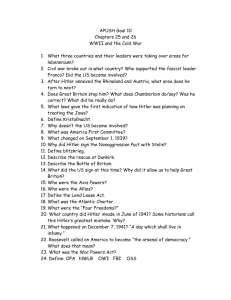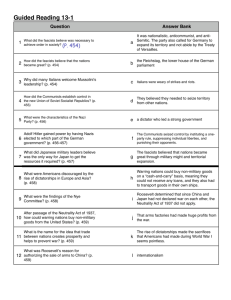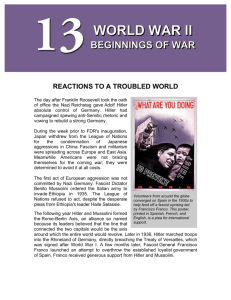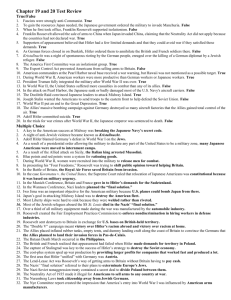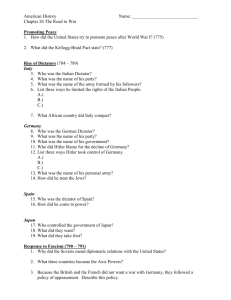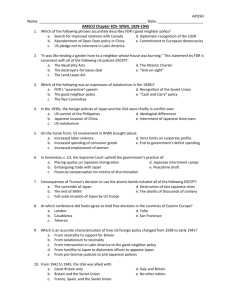World War II
advertisement
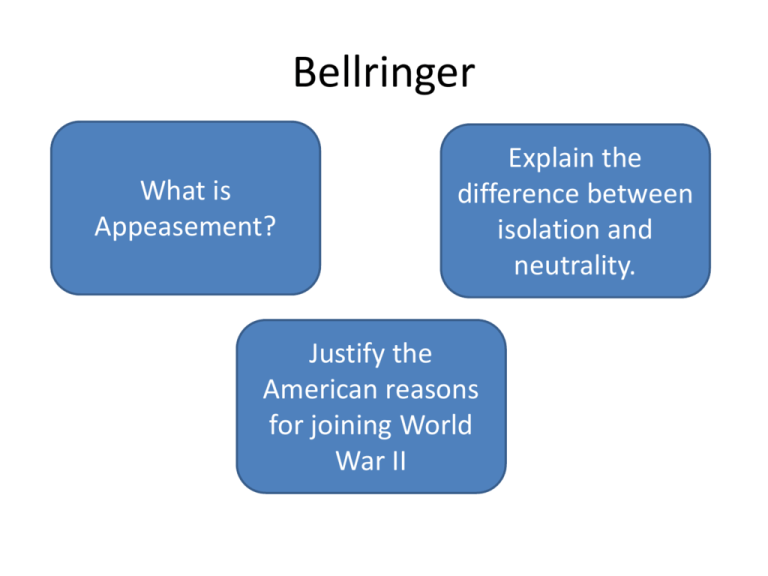
Bellringer Explain Both avoid gettingthe involved with foreign politics, but difference between neutrality includes trading The policy of giving in to an aggressor to avoid a larger What is conflict Appeasement? isolation and neutrality. Justify the American imperial interests were being threatened by American reasons Japanese expansion and for joining World aggression, peaking with Pearl Harbor War II Bellringer Determined how people would be represented: What was the Bi cameral legislature: Great House of Repspopulation Senate2 per state Compromise? President Veto of Congress Bill Provide an Supreme Court declares law example of Checks unconstitutional Congress FDR’s court andrefuses Balances. packing The 1920s and did 1930s Why included a red scare, against Hollywood make communism. However, the US now was allies with the pro-communist Communist Soviet Union films during WWII? WWII in Europe As the Depression grew worse around the world, European nations were giving up rights to totalitarian governments with a goal of expansion Prelude to War While the 1930s kept many Americans focused on their own hardships, politicians were watching as dictators in Europe and Asia expanded into other nations for resources and power. Totalitarian Regimes Germany, Italy, and the Soviet Union all created Totalitarian governments. These nations controlled all aspects of their countries and people. To maintain control these countries suppressed individual rights, killed dissenters and created terror. Germany and Italy became Fascist while the Soviet Union further developed communism. Communism vs. Fascism Communism All members of society equally own the means of production BOTH TOTALitarian governments Use terror and secret police to maintain control Fascism Private business for profit allowed, but union issues are shut down by the government Italy- Benito Mussolini Italy’s Fascist leader was Benito Mussolini, a.k.a. “Il Duce” or the leader. Mussolini’s black shirts Fascist Symbols in Italy: terrorized Italian citizens to bring them under control. Mussolini suspended elections, outlawed BLACK- color worn by Fascists political parties and used secret police to stay in control. Il Duce- Name given to Mussolini meaning The leader He also began expanding his Italy’s control over Symbol: Sticks surrounding an Ax North Africa The sticks= unity The ax= authority 4:35 German Expansion- Adolf Hitler Germany saw expansion as a way to bolster National Pride and domination. Hitler started by taking over several areas, including the mineral rich Rhineland. Britain and France worried about Hitler’s aggression but did nothing to stop him. Soon Germany made an alliance with Italy called the Axis agreement. Appeasement Britain and France were concerned about Hitler’s aggression, but reluctant to enter into another war. At a meeting in Munich, leaders from Germany, Italy, Britain and France meet. They agreed to give into Hitler’s demands for the Rhineland and Sudetenland (part of Czechoslovakia). Hitler promised to not expand further. Appeasement Giving in to aggressive demands to avoid war and keep peace WAR! WAR! WAR! WAR! WAR! In 1939 Hitler invaded Poland, the last democratic nation in Eastern Europe. The British and France declared war. Blitzkrieg Germans attempt Blitzkrieg, or lightning war, against France. The goal was to quickly invade and capture France. They accomplished their goal in just over 6 months. With France occupied Hitler could focus on attacking Britain. London Blitz England, an island nation, has natural protection from water. To attack Britain, Hitler had to rely on his Luftwaffe, German air bombers. Up to 1000 bombers attacked Britain a day. Over the course of 58 days Londoners slept in subway tunnels and over 15,000 were killed. Japan’s Empire Japan lacked resources and needed land for its growing population, so they began a process of Imperialism: -1931 Japan takes over Manchuria -1937- Japan invades North China This challenged American interests in the Pacific. To protect American interests Roosevelt began a Naval buildup and stationed the Navy at Pearl Harbor. Disillusionment Americans were reluctant to enter into the conflict in Europe. After World War I many Americans began to examine the reasons for WWI and its effects on America. Soon, Americans were torn between Isolation and Neutrality. Isolation Neutrality Do not want any contact with the outside world, not even trade Do not want to get involved in the politics of foreign nations, but still want to trade Neutrality Acts 1935-1937 In the end Congress settled on a policy of Neutrality. Congress declare that the US would withhold weapons and loans from all nations at war, including Britain and France. Also, all nonmilitary goods sold to warring nations must be paid for in cash, no loans would be allowed. Cash and Carry American policy to sell military goods for cash only (no loans) Lend-Lease Acts As the war dragged on, Franklin Roosevelt pushed Congress to pass the Lend Lease Acts. These laws allowed the US to lend ships, tanks, planes and other military supplies to countries who defend democracy. After the war they would return the supplies or pay for anything destroyed. “Arsenal of Democracy”will sell supplies to democratic allies Leading to Pearl Harbor When France fell from Germany’s Blitzkreig, the Japanese took its colony in Indochina. The US retaliated by cutting off all trade with Japan and freezing its assets in the US. The Japanese were angry about this, but both the Japanese Emperor and Roosevelt worked for peace, until intercepted messages indicated Japan was planning further expansion. Pearl Harbor Lives in infamy Roosevelt pledged to stay out of the war because the US was not directly involved. However, the Japanese, angry with the US for halting trade with Japan, bombed the Navy base at Pearl Harbor. 3:50 2:37 1:40 Infamy Roosevelt declared Pearl harbor as the day that will live in infamy, an asked Congress to declare war. America officially enters the war on December 11, 1941. Japan attacked on the morning of Sunday Dec. 7th with 180 planes. American losses: -2400 Americans Killed -1200 Wounded -300 Planes damaged or destroyed -18 Warships sunk or damaged -8/9 battleships destroyed or damaged Japan only lost 29 planes Allies vs Axis Allies Axis Britain- Winston Churchill France- Charles de Gualle Germany- Hitler Italy- Mussolini Soviet Union- Stalin America- Franklin Roosevelt (Harry Truman) Japan-Hirohito The War at Home World War II was another total war, with all the nation’s resources going towards the war effort. To get the nations through the war the US did many things: -rationing -War bonds -Hollywood dramatizations -Japanese Internment -Women workers and army corps -Arsenal of Democracy Rosie the Riveters Just like WWI, Millions of women joined the workforce to work in factories to manufacture military supplies, ammunition and weapons. Many of these women were married mothers, a first for America. Even after the war many of these working mothers became the norm. Hollywood goes to War To keep the Americans into the war effort, the American government worked with Hollywood to promote the war and create propaganda ads. These ads accomplished several purposes: -Promote war effort and patriotism -Warn against “Loose Lips” -Created films favorable to the Communist Soviet Union Executive Order 9066 Roosevelt pushed Executive Order 9066 to protect the US. Japanese Americans were interned, or kept, in large camps to “protect” the United States from Japanese spies. Most of the Japanese Americans in the camps were born in America. **In times of war, civil liberties may be limited** Korematsu vs United States (1944) The Supreme Court declared that forcing Japanese Americans into internment camps was a reasonable wartime emergency action. However, no acts of treason were found and thousands of Nisei fought in the war. Finally, in 1988 the American government admitted the relocation was unjust, and paid $20,000 to each surviving Japanese American who had been in the camps. Arsenal of Democracy The Lend-Lease Act had America contributing military supplies long before Americans ever joined the war effort. Once America declared war, US factories had to turn out even more war supplies to satisfy the demand for American soldiers and from all the allied nations, Great Britain, France and the Soviet Union. Production ramped up to unprecedented levels. Wartime production: 300,000 planes 100,000 tanks 5,600 “Liberty Ships” 6 million rifles 41 billion rounds of ammo Tuskegee Airmen The most distinguished of the African units was the Tuskegee Airmen, the first black unit of military pilots. There were 994 African American pilots in the unit, winning many medals and awards. However, despite their heroism, they still dealt with racism and segregation. After WWII, the role of Africans in the war pushed President Harry Truman to sign Executive Order 9981, ending segregation in the armed forces. Nisei soldiers Despite the injustice of Japanese internment camps and limited civil rights, thousands of Japanese Americans joined the military, proving their loyalty and will to fight. The 442nd Regimental Combat team, made up of only Japanese Americans, won more medals than any other unit of similar size. America’s Two Front War American troops helped turn the tide of the war in Europe, eventually ending the war after the Battle of the Bulge, capturing Berlin and accepting Germany’s surrender on May 8th, 1945. However, at the same time, American troops were fighting in the Pacific. Turning Point: European Theater SPR Dwight Eisenhower planned an Allied invasion of France. To prepare, the Allies constantly bombed German factories, aircraft sites and military supply warehouses. The Allies stormed Normandy’s beaches on June 6, 1944 with 176,000 troops. Invasion 3:44 Aftermath 3:53 Pacific Island Hopping After suffering some major defeats to the Japanese in the Pacific, American troops, under the lead of General Douglas MacArthur, began a campaign of island hopping. The Americans selectively attacked specific enemy held islands. However, the Japanese fiercely defended their positions, causing massive casualties on both sides. Battle of Iwo Jima One of the bloodiest battles of the war, the Americans shelled the tiny, volcanic island for 74 days, dropping over 20,000 shells onto the island. However, the steep rocky terrain was honeycombed with caves and tunnels that largely protected the Japanese. An invasion of the island included 110,000 American troops and a month to secure the island. Manhattan Project While the military island hopped the Pacific, scientists in the US were studying ways to harness the power of the atom. In July 1945 detonated first Atomic bomb test President Truman ordered Japan to surrender of face “Utter and complete destruction” Atomic bombs dropped: Hiroshima- 8/6/45- 70,000 killed instantly Nagasaki- 8/9/45- 40,000 killed instantly **many more die from radiation exposure over time** Japanese Occupation After the surrender, American troops led by General MacArthur occupied Japan. These troops forced democracy and a constitution onto Japan. This new constitution was nick-named the “MacArthur Constitution”. This constitution set up a democratic government, though emperor Hirohito remained, he was just a figurehead with little real power. Integrated Military As a result of the sacrifices of the many African American units in the War, President Truman signed executive order 9981 which forced the integration of the armed forces. However, despite the executive order, change was slow to occur. It wasn’t until the Korean War of 1950 that integration truly occurred. "equality of treatment for all persons in the armed services, without regard to race, color, religion or national origin. The Holocaust and St. Louis Hitler’s Final Solution to get rid of the Jewish in German occupied lands resulted in the murder of over 6 million Jews, and an additional million dissidents, gypsies, homosexuals and others. The passenger ship the St. Louis carrying over 900 Jewish passengers left Europe, bound for Cuba. However, when they arrived Cuba and United States refused to help. The passengers were forced to return to Europe and most died in the Holocaust. Nuremberg Trials During 1945 and 1946, a War criminal trial was held at Nuremberg, Germany. This court tried 24 high level NAZI officials and other lower ranking guards. This was the first time that military personnel were tried for crimes committed during war. Demobilization During the war American factories increased production pulling the nation out of the Great Depression. As America returned to a peacetime civilian nation, factories also transitioned to consumer goods. The armed forces went through a major reduction, from 12 million members to 1.5 million. DemobilizationConverting (changing) from a wartime to peacetime society. GI Bill The Servicemen’s Readjustment Act (The GI Bill of Rights) put billions of dollars aside to pay for veterans’ benefits like college, medical treatment and unemployment. The Bill also provided low cost loans to GIs for Homes and business startups. As a result more people attend college and buy homes than ever before. Baby Boom As soldiers returned home and relative prosperity, many married and started families. The birth rate spiked, leading to the Baby Boom. Today the baby boomers are about to retire, causing stress on our social security, retirement and elderly care services. Truman’s Fair Deal Like FDR, Truman believed government spending could help promote the economy. Truman proposed laws that promoted employment, raised minimum wages and even universal healthcare. However, Congress denied most of Truman’s proposals. Truman and Civil Rights Truman supported Civil Rights and met with African American leaders in 1946 who asked Truman for a Federal anti-lynching law, abolishment of poll taxes and to find ways to stop hiring discrimination. Executive Order 9981- End segregation in American military, but it wasn’t enforced until the Korean War in 1950 Big Idea World War II forced America to step up as a World Power. However, at the beginning the Americans chose neutrality, staying away from foreign politics but partaking in trade. This trade pulled America out of the Great Depression, and eventually pulled America into the war. Americans helped close the American theater before focusing on the Pacific war against Japan. Ultimately the Japanese surrendered after significant losses from Atomic Bombs. As the Americans returned to peace time the government took action to keep the economy prosperous. Review A major reason for the United States neutrality in the 1930s was that nation’s a. Belief in the domino theory b. Disillusionment resulting from World War I c. Strong approval of political conditions in Europe d. Military and naval superiority Review At the outbreak of both World War I and World War II in Europe, public opinion in the US generally favored a. Remaining neutral b. Entering the war on the side of the Allies c. Invading Europe in order to acquire territory d. Settling the conflict through an international peace organization Review The appeasement policy followed by Western European leaders in the late 1930s was based primarily on the belief that war could be avoided by a. Satisfying Hitler’s desire for territorial expansion b. Encouraging communist expansion into NAZI Germany c. Limiting the development of Germany's armed forced d. Appealing to the league of Nations for international cooperation Review After World War II, the United States was better able than its allies to adjust its economy from wartime to peacetime because the United States a. Possessed nuclear weapons b. Raised tariffs on imports c. Had collected its war debts from the Allies d. Had suffered no widespread wartime destruction Review What was a major effect of World War II on women and minorities in the United States? a. The were drafted into the military b. They had new opportunities in the workforce c. They received equal voting rights for the first time d. They were granted equal pay for equal work Review During World War II, the action required by this announcement was based largely on a. Racial prejudice b. A labor shortage c. The needs for skilled workers in defense industries d. A desire protect Japanese Americans from military attack All Japanese persons, both alien and non-alien, will be evacuated from the designated area by 12:00 noon Tuesday, April 7, 1942 World War II Recap
